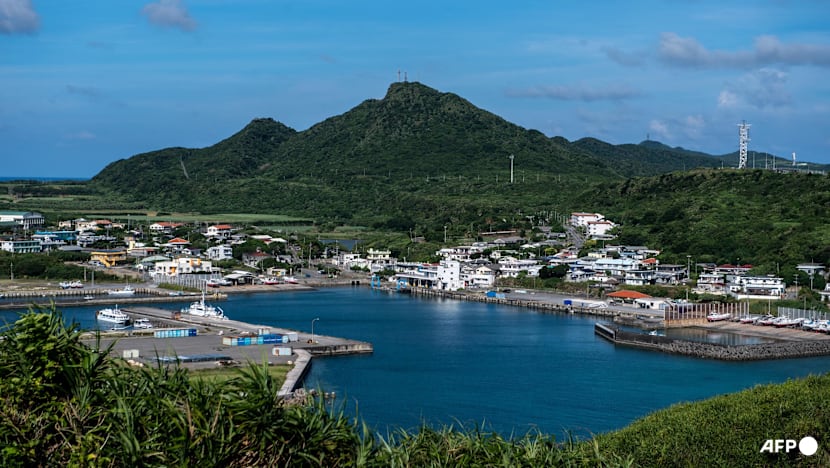analysis East Asia
What the Trump-Xi call reveals about their priorities on Taiwan, Japan and beyond
Clues of their respective agendas lie in what each side has chosen to emphasise - and omit - in their public statements on the call between US President Donald Trump and Chinese supremo Xi Jinping, analysts tell CNA.


This audio is generated by an AI tool.
BEIJING/SHENZHEN: United States President Donald Trump and Chinese counterpart Xi Jinping held a phone call less than a month after meeting in South Korea - an unusually swift follow-up shaped by heightened Sino-Japanese tensions and markedly different priorities, say analysts.
They add that the more revealing signs of their respective agendas lie not in the conversation itself, but in what each side has chosen to emphasise - and to leave out - in their public statements.
Observers say the leaders’ phone call on Monday (Nov 24) offered Beijing an opportunity to reassert its position on Taiwan, express its displeasure towards recent remarks by Japan’s Prime Minister Sanae Takaichi, and possibly draw Washington into applying pressure on Tokyo.
Takaichi’s remarks earlier this month that a Chinese attack on Taiwan could justify a Japanese military response have drawn fierce backlash from Beijing and triggered knock-on effects from tourism and travel disruptions to a cooling of cultural exchanges.
“Forcing Takaichi to retract the statement and pressuring the US to accept China's authority over Taiwan will be Xi's ultimate goal,” Gary Ng, a senior economist at Natixis and a research fellow at the Central European Institute of Asian Studies, told CNA.
As for Trump, analysts said his priority was to keep the momentum going on his broader trade truce with China and avoid letting regional frictions complicate negotiations.
At the same time, some observers suggested he also wanted to signal reassurance to Tokyo through a back-to-back call with Takaichi - their first conversation since her remarks on Taiwan.
The trajectory from here, according to analysts, will be shaped by key indicators, including any changes in Chinese military activity around Taiwan, adjustments to US-Japan coordination, and whether the different parties move to recalibrate their messaging.
SAME CALL, DIFFERENT NARRATIVES
The Monday phone call between Trump and Xi came three weeks after both leaders met face to face in Busan, South Korea on Oct 30. The call was not flagged in advance by either the US or China.
It was initiated by the US side, Chinese foreign ministry spokesperson Mao Ning said on Tuesday. The conversation was “positive, friendly and constructive”, and the two leaders discussed issues of mutual concern, she said during a routine briefing.
The call lasted for about an hour, according to White House Press Secretary Karoline Leavitt.
Readouts from both sides praised improvement in US-China relations.
In a post on his Truth Social platform, Trump said bilateral ties were “extremely strong” and touted “significant progress on both sides in keeping our agreements current and accurate”.
Meanwhile, the Chinese readout by Xinhua state news agency described the China-US relationship as generally maintaining a “steady and positive trajectory”, welcomed by both countries as well as the international community.
“The vision of China and the US helping each other succeed and prospering together is a tangible prospect within reach,” it stated.
The Russia-Ukraine war was also discussed, according to both sides. But the convergence largely stopped there.
While Trump did not mention Taiwan at all in his post, China’s account devoted significant space to Xi’s remarks on the self-ruled island, which Beijing claims as its territory.
“He underscored that Taiwan’s return to China is an integral part of the postwar international order … the US understands how important the Taiwan question is to China,” said the Chinese readout, referring to the Chinese president.
UNPACKING THE MOTIVATIONS
Analysts said the Xi-Trump phone call underscores leader-level diplomacy as the key tool for setting guardrails and signalling intent when tensions spike.
From Beijing’s vantage point, the call was about continuity and control, they added.
Diao Daming, a professor at Renmin University of China’s School of International Studies, called it “a continuation of the Busan meeting”.
He said that given the current regional mood, the two powers needed to send a stable, positive signal through “timely communication and dialogue”, build more common ground and manage regional dynamics responsibly.
Ng from Natixis said Beijing wanted Washington squarely in the loop on Japan.
After recent frictions, it is “natural” to bring in the US because “the Taiwan problem is a US-China problem”, he said, adding that Xi’s endgame would be to pressure Tokyo into walking back its stance and push Washington toward accepting China’s authority on the issue.
In a personal commentary on microblogging site Weibo published on Tuesday, Shen Yi, a professor at Fudan University’s School of International Relations and Public Affairs, argued that China’s stance is explicit: Taiwan’s “return to China” is part of the post-1945 settlement, anchored in documents such as the Cairo Declaration and Potsdam Proclamation.
Challenging that, he said, is not only a provocation toward China but a challenge to a postwar order that China and the US have jointly upheld.
In his view, Trump’s acknowledgement of China’s World War II contribution and understanding of Taiwan’s importance to China - as stated in the Chinese readout - is a signal that the US “does not endorse” Japan’s recent remarks.

On Washington’s side, analysts see a narrower, pragmatic aim.
Diao from Renmin University of China said Trump’s subsequent call with Japan’s leader shows attention to the region and a desire to avoid developments that could complicate the broader US agenda.
Wu Se-chih, an assistant professor at Taipei University of Marine Technology, noted that Trump has his own agenda with Beijing and “wouldn’t want the conversation, at this moment, to be pulled into” Taiwan or China-Japan issues.
After all, a “Taiwan contingency” sits squarely within US-Japan security cooperation on “situations in areas surrounding Japan”, Wu told CNA.
“After Trump spoke with Takaichi, she quickly emphasised that the call further strengthened the US-Japan security and alliance cooperation,” he added - a public cue, in his reading, that Tokyo heard no ask to walk back its position.

Trump “certainly cares” about key trade issues such as rare earths and the US-China trade squeeze, Wu asserted. Since the Oct 30 Busan meeting, both sides have touted incremental progress on economic- and technology-related understandings.
At the same time, Trump’s participation in the call also suggests he wanted to hear Xi’s thinking and gauge “what bargaining chips might be in play” for future talks, Wu said.
WHAT’S NEXT?
In his Truth Social post following the call on Monday, Trump said Xi has invited him to visit Beijing in April, which he accepted, and that he will in turn welcome the Chinese leader for a state visit later next year.
With another round of top-level diplomacy now on the horizon, analysts said the next few months will be important in signalling whether tensions ease or intensify, with military movements and signs of economic coercion seen as the main indicators to watch.
Chong Ja Ian, an associate professor of political science at the National University of Singapore, said monitoring Chinese military and paramilitary activity near Japan, disputed areas or Taiwan will be key.

Japan confirmed on Nov 23 that its plans to deploy medium-range missiles on Yonaguni, an island close to Taiwan, were moving forward. China has criticised the move, calling it a deliberate attempt to “create regional tension and provoke military confrontation”.
“We could also look at whether economic coercion rises further. These, in conjunction with strong diplomatic language, may suggest escalation,” Chong added.
“Angry diplomatic language alone from the PRC (People’s Republic of China) may indicate a desire to climb down while not looking like it is retreating.”
China has advised its citizens against travelling to Japan - a move which has led to a spate of Japan-bound flight cancellations - reportedly reimposed a ban on Japanese seafood imports and also scrapped concerts with Japanese musicians.
Echoing Chong’s remarks, Ng from Natixis added that a state-led boycott of Japanese goods will be a significant sign.
At the same time, US politics could also shape regional dynamics, analysts said.
How Trump executes his “America First” agenda could push the region toward revived great-power “spheres of influence”, with the current Japan-China flare-up acting as an accelerant, said Steven Okun, the CEO of Singapore-based geostrategic consultancy APAC Advisors.
“While we may not witness a literal ‘Yalta 2.0’, the results could be similar, with the US ceding its active engagement in the Taiwan Strait to China,” Okun told CNA, referring to the 1945 Yalta Conference where the Allied powers negotiated the post-WWII order in Europe.
Okun suggested a clear watch window “from now through April” when a Trump visit to Beijing is slated.
The test, he said, is whether the White House trades near-term US economic wins for “political gains to China regarding Taiwan”, and whether any shift shows up in official US posture.
That being said, China hawks in Congress and within the administration are likely to push in the opposite direction, working to prevent any softening and possibly to harden policy instead, Okun noted.
Some analysts said the Trump-Xi call points to a more positive trajectory for both US-China ties and the regional landscape, or at least not a worsening one.
“I suspect Trump may have given some warnings in his conversation with Xi - namely, not to let the conflict keep heating up,” said Wu from Taipei University of Marine Technology.
“In that scenario, it seems unlikely she (Takaichi) would casually crank up the hostility spiral, which aligns with Japan’s long-standing view that the China-Japan relationship should maintain a degree of stability.”
Fudan University’s Shen suggested that both the US and China are signalling a willingness to manage competition, expand cooperation and steady the relationship through continued high-level engagement.
“From the Busan summit to subsequent steps, both sides have shown a clear will to pursue win-win outcomes and to manage competition through coordination,” Shen said, adding that economic cooperation is again functioning as a “propeller” in the relationship.
“The path won’t be perfectly smooth, but the direction is clear: if both sides earnestly implement the leaders’ consensus and uphold equality, mutual respect and reciprocity - shrinking the list of problems and lengthening the list of cooperation - economic ties can continue to serve as ballast, even as a new engine.”





















